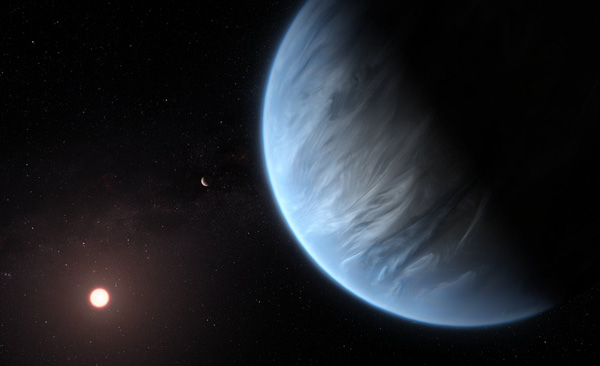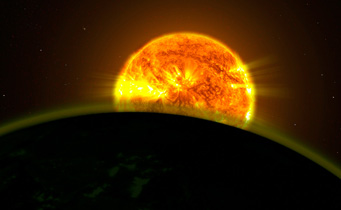Milestone: Astronomers Discover Water Vapor on a Super-Earth – Sky & Telescope
Two independent teams have discovered the signature of water vapor in the atmosphere of super-Earth K2-18b.

This artist’s impression shows the planet K2-18b, its host star, and an accompanying planet in this system.
ESA / Hubble / M. Kornmesser
In a milestone for exoplanet research, two independent teams of astronomers have detected water vapor in the atmosphere of the planet K2-18b.
The planet is rocky, but it’s no Earth twin. At almost three times Earth’s diameter and between 7 and 10 times its mass, K2-18b is a super-Earth, a type of planet abundant in the galaxy, even though it’s absent from the solar system. Some super-Earths have turned out to be more like sub-Neptunes, with big gaseous envelopes, but this planet’s average density is similar to the density of the Moon or Mars.
So far, attempts to gauge the atmospheres of terrestrial super-Earths have failed, either because of thick clouds (as was the case for Gliese 1214 b and HD 97658 b), a lightweight, featureless atmosphere of just hydrogen and helium (as for 55 Cancri e), or no atmosphere and no clouds at all (as for six of the planets in the TRAPPIST-1 system).
K2-18b is intriguing in part because, like the TRAPPIST-1 planets, it orbits in the habitable zone of its red dwarf star. It circles its star every 33 days, but the star — less than half the size of the Sun — is redder and fainter, providing just enough light to keep water liquid on the planet’s surface. And at just 110 light-years away, this super-Earth seemed a good candidate for further studies of its atmosphere.
The Presence of Water
Björn Benneke (University of Montreal) led a team in applying for time on the Hubble Space Telescope, observing the planet as it crossed the face of its star. The team’s analysis of eight of these transits, as well as transits observed by the Kepler and Spitzer space telescopes, will appear in the Astronomical Journal. Another team based at the University College London, including lead author Angelos Tsiaras, published an independent analysis of the same Hubble data, now publicly available, in Nature Astronomy on September 11th.
Both teams found that water vapor is almost certainly present in the atmosphere of this super-Earth. Beyond that, the data are fuzzy: It’s not clear how much water is present, or even in what form.
That’s largely because the researchers are taking a transmission spectrum of the planet as it passes in front of its host star — that is, they’re looking at the star’s light as it passes through a thin sliver of the planet’s atmosphere.

NASA scientists found faint signatures of water in the atmospheres of five hot Jupiters. All five planets appear to have a high-altitude haze that weakens water’s signal from deeper within their atmospheres.
This kind of observation doesn’t give a lot of information about how temperature and pressure change with altitude, which leaves astronomers in the dark about everything from composition to the structure of the rocky world itself. The planet could, for example, be a waterworld, but that’s an idea the observations can neither confirm nor deny.
“We’re really careful of overstating what we can extract from these observations,” says Giovanna Tinetti (UC London).
What Kind of World Is This?
Ingo Waldman, on the University College London team, explained that three different scenarios fit the data equally well: The atmosphere could be pure hydrogen with lots of water, or the atmosphere could contain hydrogen and nitrogen with just a little bit of water. Or a third option allows for a hydrogen atmosphere, a “tiny speck” of water, and high-altitude clouds or hazes that obscure the view.
Benneke and his colleagues throw in another option: liquid water in addition to water vapor. Their calculations suggest that it could rain in the mid-atmosphere of this world.
More data will help determine whether these scenarios are right. Hubble provides the wavelength range ideal for investigating the presence of water, and this can now be done for other super-Earths as well. Ultimately, though, the broader range of wavelengths and higher-resolution spectra that the James Webb Space Telescope will offer will be key to exploring this world.





